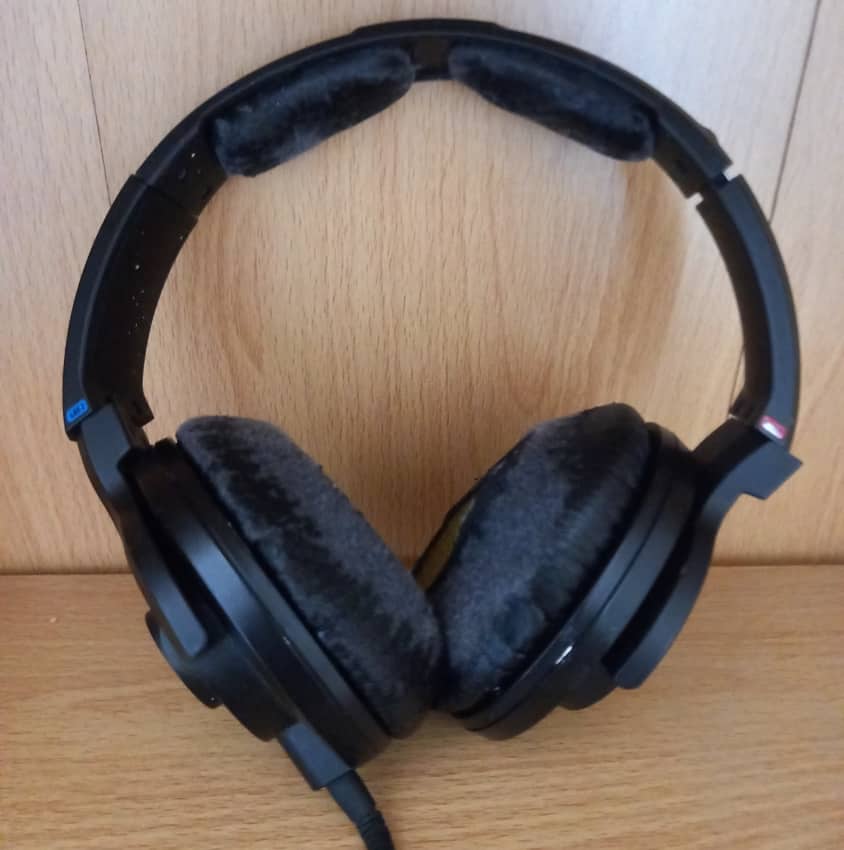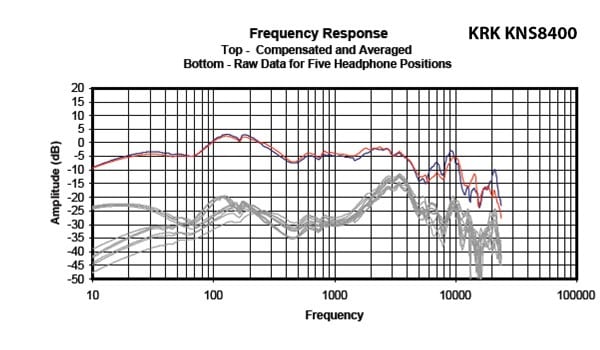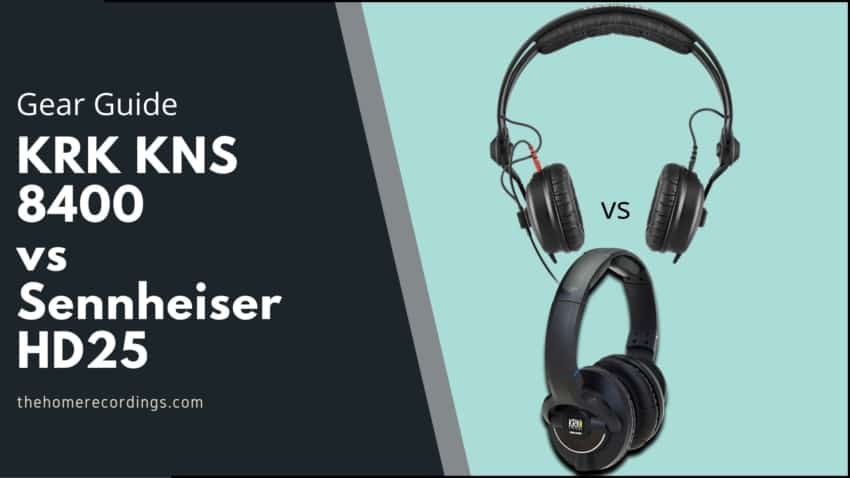Last updated on December 30th, 2023 at 02:57 pm
I have two pairs of headphones that I use daily, the KRK KNS 8400’s and the Sennheiser HD25’s. They are two solid pairs of headphones, but each has their strengths and weaknesses. If you are wondering which is better, read on – I am going to be answering exactly that.
Which is better, the KRK KNS 8400 or the Sennheiser HD25? The KRK KNS 8400 is a comfortable pair of over-ear headphones with a large frequency range making them great for long listening and production sessions, while the Sennheiser HD25 are on-ear headphones with a high contact pressure and block background noise, making them better for DJing and live performances.
KRK KNS 8400

The KRK KNS 8400’s is an over-ear styled pair of headphones intended for audio production and listening. I bought these around 10 years ago as my first pair of ‘proper’ headphones, and they are still sounding great to this day (although they look seriously beaten-up).
The frequency range is from 5Hz to 23,000Hz, and they have a noticeable high-range boost at the 3-5kHz region of around 3dB which leaves the quality sounding crisp. Whilst the high-end does sound great, this boost can be a pain – I often find under-compensating my treble EQ when mixing with these headphones, having to re-EQ a track after hearing it through a pair of monitor speakers.
Although the headphones are made mostly from plastic (other than the adjustable steel headband mechanism), they feel sturdy, sleek and comfortable. I could wear these headphones for hours at a time without worrying about discomfort. This is due to the ear pads being made from memory foam and the cushions of the headband being wrapped in soft leather.
However, as mentioned my pair has deteriorated over the 10 or so years that I have owned them (specifically with the foam becoming exposed and misshapen), but that is to be expected.
Furthermore, the earcups rotate 90 degrees on their axis which is great for folding and durability, also giving the feeling of the headphones being robust and hard to damage. One interesting feature about the 8400’s that make them stand out is that the headphones are separate to the cable. The headphones come with both a 2.5m cable with a 3.5mm connector in addition to a headphone control cable.
This is a nice feature when casually listening to music as it allows you to adjust your volume without touching your device. However, it must be said that this is a bit sensitive, and there have been many times when I have been producing music and I have accidentally lowered the volume control, altering my perception of the loudness of my mix. Regardless, it is a good feature and the cable is a decent length.

What comes in the Box?
- KRK KNS 8400 Headphones
- 2.5m Audio Cable
- Volume Control Cable
- Soft Case
- Cleaning rag
- Manual
Specifications
| Style | Over Ear |
| Frequency Response (Hz) | 5 – 23000 |
| Connectivity | Wired |
| Impedance (Ω) | 36.0 |
| Driver Size (in) | 1.57 |
| Total Harmonic Distortion | 0.1% |
| Maximum Input Power (mW) | 1000 |
| Connector | 3.5mm |
Find out more about the KRK KNS 8400 here:
- KRK KNS 8400: Amazon, Sweetwater.
Sennheiser HD-25

The Sennheiser HD-25 headphones are on-ear styled headphones that are aimed towards monitoring audio and hence are one of the most common pairs of headphones that DJs use. I initially bought these on recommendation from a friend and I was trying to mix tracks in a loud setting with my 8400’s, and the noise spill was simply too much.
The high on-ear pressure of 2.5N blocks background noise out very well without the need for noise-cancelling software. They quickly solved this problem for me, and I have not used another pair of headphones when DJing ever since.
They have a frequency range of 16 – 22000Hz, and generally sound a bit grittier and lower than the 8400’s. However, with their intended purpose of DJ use, this does not matter to me too much.
The bass feels powerful and the overall perceived quality is good enough for what I use them for. However, the biggest downfall of these headphones is the comfort. After wearing them for 30 to 60 minutes, my ears will begin to ache despite if the volume is quiet or not.
The clamped pressure on the ears feels a little bit ‘crushing’, although this feels like a necessary evil to block background sound effectively in loud environments.
The headphone’s build itself looks quite fragile with its thin frame and exposed wires, and the light-weight nature feels like they could easily be damaged. However, I have not found this to be the case and my pair have taken its fair share of beatings being shoved into backpacks and used at live performances.
A standout feature for these headphones in terms of build is that each headphone can be swiveled 90 degrees vertically, allowing for single ear listening (another reason they are great for DJing).

What comes in the Box?
- Sennheiser HD-25 Headphones
- 1.5m Audio Cable
- Manual
Specifications
| Style | On ear |
| Frequency Response (Hz) | 16 – 22000 |
| Connectivity | Wired |
| Impedance (Ω) | 36.0 |
| Total Harmonic Distortion | 0.3% |
| Maximum Input Power (mW) | 200mm |
| Connector | 3.5mm |
Find out more about the Sennheiser HD25 here:
- Sennheiser HD25: Amazon, Sweetwater.
Main Differences
The main differences between these two pairs of headphones is the frequency range, the style, and the purpose of them. The KRK KNS 8400’s has a high frequency range, over-ear style and are very comfortable but they don’t isolate you from outside noise and whatever you’re listening to will also bleed outwards.
The Sennheiser HD-25’s have a lower frequency range and are not as comfortable, but the on-ear pressure is excellent for monitoring audio in a loud environment such as DJing in a club.
Conclusion
Overall, both the KRK KNS 8400’s and the Sennheiser HD-25’s are high-quality headphones that feel durable and do great at their specific jobs. The 8400’s offer a higher frequency range and level of comfort, making them a good choice for long production sessions and relaxing to your favorite album. However, the open-ear nature of them renders them useless in a loud environment.
The Sennheiser HD-25’s on the other hand are not nearly as comfortable as the 8400’s (even uncomfortable after long sessions using them). They also have a lower frequency range, but the high-pressure on-ear style means that the headphones excel when it comes to monitoring audio while DJing or performing live.
